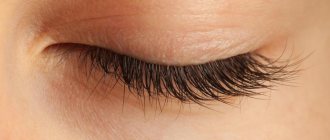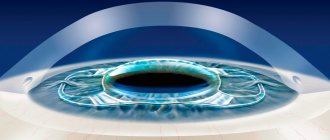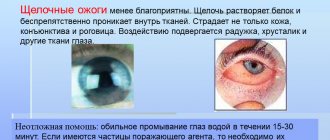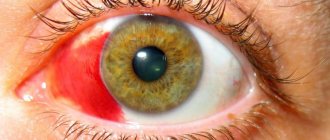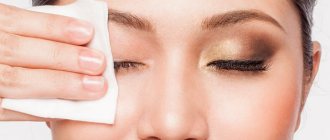The effect of alcohol on vision
Ophthalmologists concluded that alcohol-containing drinks negatively affect the functioning of the optical system. When ethyl alcohol enters the body, disruption of the central nervous system begins almost immediately.
With the short-term influence of alcohol, a slowdown in the interaction of neurotransmitters is observed. Receiving information from the outside becomes difficult, and the relationship between the body and brain is disrupted.
With the short-term influence of alcoholic beverages, the coordination of the eye muscles is disrupted, which leads to various disturbances in visual perception. The pupils cannot dilate and contract correctly, and the ability to distinguish certain colors decreases.
A study was conducted in Canada. Scientists have found that ethyl alcohol reduces the ability to distinguish between light and dark by 30%.
The short-term effect is reflected by cephalalgia, inflammation and hyperemia. A nervous tic called myokymia is possible.
Long-term exposure to toxic substances leads to more serious conditions. With regular consumption of drinks with ethyl alcohol, it is possible to develop certain eye diseases. These phenomena do not go away after stopping alcohol abuse. To get rid of them, it is necessary to carry out complex treatment.
Why do my eyes hurt after drinking and after a hangover?
How alcohol affects vision when it breaks down in the human body. The resulting substances have a detrimental effect on the nervous system, reducing its sensitivity. The optic nerve does not receive enough of the substances it needs, resulting in damage. Nerve fibers begin to die.
We suggest you read: What to add to alcohol to induce vomiting
In some ways, the optic nerve is like a telephone wire, providing communication between the brain and the eye. It consists of a huge number of fibers and is protected by a specific shell. Why does it atrophy after drinking?
Fiber damage occurs. The result is the loss of individual sections of the image. An incomplete picture is formed in the brain. Areas called “blind spots” appear. A clinical picture characteristic of optic nerve atrophy develops:
- eyes hurt when moving;
- the visibility zone is narrowing;
- vision becomes tunnel vision - objects are visible, as if the patient is looking through a specific tube;
- visual acuity decreases.
Moreover, it is almost impossible to correct this situation. The disease gets worse over time. If the patient does not stop drinking, he will face complete blindness. Moreover, the rate of development of pathology is different in all patients. Some people become blind faster, while for others the process is slow.
If the patient does not stop drinking, he will face complete blindness
Double vision after drinking alcohol
This condition is called alcoholic diplopia. Due to the toxicity of alcoholic drinks, inhibition begins in the oculomotor center of the brain. Muscle fibers contract poorly and work is disrupted. This is why you see double after drinking alcohol.
Both eyes function but cannot converge on the correct target object. Diplopia can be vertical and horizontal at the same time, or objects can be rotated relative to each other.
Alcoholic diplopia is manifested by dizziness, problems with orientation in space, and difficulties in assessing the location of objects. If the toxic effect has affected the oblique muscles of the visual analyzer, diplopia develops in the form of an arrangement of objects one above the other.
Alcoholic diplopia does not require treatment. After heavy drinking and the release of toxic components from the blood, vision is restored. Diplopia can recur with subsequent consumption of ethyl alcohol in small or large quantities; the amount of alcoholic drinks is different for each person.
The influence of alcoholic beverages on alcoholism
The effect of alcohol on vision has been studied by many scientists. People who abuse alcohol always have red eyes. This process is due to the fact that ethanol negatively affects the circulatory system and blood vessels. Ophthalmologists observed patients for a long time and concluded that alcoholics are more likely to experience the following pathological conditions:
- corneal diseases;
- pathological changes in the retina;
- ametropia (the eyes cannot perceive light rays normally and refract them);
- astigmatism (the shape of the lens loses its original shape).
All these diseases and pathological conditions lead to a person’s vision gradually deteriorating.
Redness of the eyes after alcohol
Hyperemia of the sclera is the most common symptom of a hangover. When you abuse alcohol, intracranial pressure increases, the vessels cannot withstand it and burst. This is manifested by small hemorrhages in the eyes and their redness.
Frequent consumption of alcoholic beverages leads to disruption of blood microcirculation in the visual analyzer. Patients experience constant hemorrhages.
Hemorrhages are an accumulation of blood flowing from small capillaries and vessels in the eye. Hemorrhage can be pinpoint or flat.
Vascular rupture is accompanied by the following symptoms:
- cramps;
- itching.
Hemorrhage during alcohol intoxication does not cause pain, changes in visual perception and is not accompanied by discharge from the eyes.
Hemorrhages go away after a few days. This condition usually does not require treatment.
If you regularly drink large amounts of alcohol, flushing will become a chronic symptom. Against this background, visual perception will deteriorate.
How does alcohol affect vision: why do eyes turn red?
So alcohol affects not only the brain or nervous system. The eyes are also affected by it, and its effect on the organs of vision is very powerful. It is not uncommon for your eyes to turn red after drinking. This condition can occur during a hangover. Reddening proteins are the result of disturbances within the circulatory system. Red blood cells fall during drinking, and along with them, hemoglobin in the blood decreases. Blood clots form. Clots interfere with normal blood flow . Normally, the eyes require a large volume of oxygen, this is a prerequisite for their normal functioning. If there is little oxygen, hypoxia is formed, as well as nutritional deficiency. The eyes do not receive enough oxygen and nutrients. A person feels that his vision is rapidly falling, his eyes are getting dark. At the same time, redness of the whites occurs.
Also, with a hangover, there is a narrowing of capillaries and blood vessels. In such a situation, capillaries can simply burst, forming those same bruises in the whites of the eyes. On the one hand, no special treatment is required; over time, the symptom goes away on its own. But on the other hand, with constant alcohol abuse, vision can be significantly damaged .
Narrowing of visual field after alcohol
The peripheral field of vision narrows by 2–3 times with systematic consumption of alcoholic beverages. Side objects almost completely disappear from a person’s view.
When the body is severely poisoned by toxic substances, tunnel vision occurs. This is when a person sees as if through a spyglass. Therefore, the risk of a traffic accident increases many times when the driver is intoxicated.
The next morning, when the hangover sets in and some of the alcohol wears off, the functioning of the visual analyzer will be restored. However, with further abuse, the tissues of the optic nerve are gradually damaged and atrophy. Narrowing of peripheral vision is one of the symptoms of atrophy.
How alcohol impairs vision
It's no secret that alcohol is harmful to human health. Not only the liver and heart are at risk, but also other organs, including the eyes. Alcohol abuse can lead to severe eye diseases, severe vision loss and even blindness. Let's find out how this happens and how to restore vision after alcohol?
Why does vision deteriorate after drinking alcohol?
The eyes are very sensitive and vulnerable, so it is not surprising that alcohol has a negative impact on their health. Ethyl alcohol has a bad effect on the functioning of all body systems, interferes with normal blood supply to organs, damages blood vessels, and causes surges in blood and intracranial pressure. Even one-time consumption of alcohol can lead to severe intoxication and serious health consequences.
The effects of alcohol on vision may be temporary. This manifests itself in symptoms such as redness of the white part of the eyeball, diplopia (double image), lacrimation (or, on the contrary, dry cornea). Alcohol abuse also causes more serious consequences - atrophy of the optic nerve and a sharp deterioration in vision. A chronic drinker risks permanent loss of visual function. At the same time, the harm that alcohol causes causes irreversible loss of visual abilities, that is, the resulting ailments cannot be treated. If this process is not stopped, it can result in incurable blindness. The danger is that visual acuity after alcohol can drop rapidly, or it can deteriorate gradually. A person often does not notice this and does not turn to an ophthalmologist.
How does alcohol affect the eyes and why does vision worsen after drinking alcohol? Let's consider how ethyl alcohol affects various structures of the eye and worsens various vision functions.
Double vision after drinking alcohol
Diplopia (double vision) after alcohol is a very common phenomenon experienced by all people who abuse alcohol. At the same time, seeing double not only while drinking alcohol, but also later, in a state of hangover. The toxic effect on the eye muscles leads to disruption of their functionality. They contract much worse, while the muscles of both eyes work uncoordinated, the visual axes shift in different directions, as a result of which double vision occurs in the resulting image. One eye in this condition usually sees worse than the other.
Redness of the eyes after alcohol
Redness of the sclera after drinking alcohol is the most common symptom of a hangover. Alcohol entering the body leads to poor circulation. The level of red blood cells in the blood decreases sharply, and their lack causes a rapid drop in hemoglobin levels and the formation of blood clots. Organs and tissues receive less oxygen and other nutrients obtained from the blood. The eyes need a constant supply of oxygen, otherwise they begin to suffer from hypoxia. The person’s vision becomes dark, the image seems blurry and indistinct. Hypoxia also manifests itself in redness of the whites of the eyes.
The vessels of the brain and eyeball are also responsible for supplying the eye tissue with oxygen. Vasoconstriction, which occurs during a hangover, causes an increase in intracranial pressure, due to which the thinnest vessels in the retina, the capillaries, burst. In this regard, after drinking alcohol, a person has a red network of burst capillaries in his eyes. Redness is accompanied by a sensation of a foreign body in the eye, itching, pain, burning, and stinging. These symptoms disappear as soon as the person copes with the hangover syndrome. They do not pose any particular health hazard. However, systematic consumption of alcohol in large quantities will lead to the fact that all these symptoms will become chronic and will be observed against the background of a general deterioration of vision.
Narrowing of visual fields after drinking alcohol
When drunk, a person often gets injured or has accidents. This happens because the field of vision after drinking alcohol narrows several times. Side objects are almost completely out of sight. With severe intoxication, the so-called “tunnel vision” effect occurs, when a person seems to be looking at the world as if through a spyglass. When a person sobers up, visual functions are restored, but chronic alcoholism radically damages the tissue of the optic nerve with its subsequent atrophy, one of the symptoms of which is a severe narrowing of the visual fields.
Contrast sensitivity of the eyes and alcoholism
Another detrimental effect of alcohol on the eyes is impaired color vision. Scientists from the University of Chile have studied the connection between alcoholism and color blindness for many years. It turns out that color perception is affected by the condition of the liver: the more it is affected by alcohol, the worse colors and shades are perceived. The last stage of cirrhosis in almost all cases provokes complete color blindness (color blindness). All organs are interconnected and damage to one system of the body leads to a decrease in the functionality of other systems. Alcohol causes a deficiency in the liver of enzymes that are involved in the synthesis of the light-sensitive pigment of the retina, which is responsible for the contrast of the image.
Alcohol and the condition of the eye lens
The lens consists of proteins, and alcohol oxidizes them. This is one of the main causes of cataracts - clouding of the lens. Scientists have long come to the conclusion that the predisposition of people who smoke and drink alcohol to cataracts is much higher.
Vision is severely impaired after drinking alcohol: what to do?
Alcoholism leads to a very severe ophthalmological pathology - optic nerve atrophy, which can cause blindness. Of course, a one-time intake of alcohol-containing drinks is not capable of provoking such a disease. We are talking specifically about chronic alcoholism. Atrophy occurs as a result of ethanol preventing adequate nutrition of the nerve. Because of this, its fibers die, which cannot be restored.
Optic nerve atrophy has the following symptoms:
• color vision impairment;
• loss of entire sections of the image from the field of view (so-called “blind spots” appear);
• severe narrowing of visual fields;
• eyes and head hurt when moving the eyeballs.
The pathology progresses very quickly, but a person who drinks too much may not notice them. He is in danger of losing his visual acuity to the point of complete blindness.
The harm of alcohol increases many times over if the alcoholic drink is of poor quality. Surrogates can cause complete blindness and other severe eye diseases even after a single use. It is worth saying that there is no harmless alcohol. Ethanol, which is dangerous to health, is found in varying quantities in all alcohol-containing drinks, including low-alcohol cocktails and light beer.
How to restore vision after drinking alcohol?
If you are planning a feast, it is better to take “precautionary measures” in advance. To do this, you can drink several tablets of activated carbon. It will reduce the effect of ethanol on the body. The next day after drinking alcohol, it is necessary to restore the balance of salts and fluids in the body. This will help improve your overall condition. To relieve redness from the eyes, dryness, burning and other unpleasant symptoms, you can use moisturizing drops. You can relieve swelling from the eyelids and eyes, and remove bags under the eyes using lotions and compresses. Raw potatoes, cucumber or herbal infusions are absolutely harmless (except in cases of allergies to certain foods) and can be used without a doctor's prescription.
You need to know that you should not drink alcohol if you have diseases, including eye diseases. Ethanol reduces the body's ability to recover and resist infection. In addition, most medications are incompatible with ethyl alcohol. Their combination can cause complications.
Come for a diagnosis at the Kazakh Research Institute of Eye Diseases at the address: Almaty, Tole bi street, 95a (corner of Baitursynov street). Telephone; +7 (727) 279 54 36
Exacerbation of ophthalmic diseases after alcohol
Bad habits don't lead to anything good. Even minor alcohol abuse affects the health of the visual analyzer. Exposure to alcoholic beverages leads to numerous pathologies and exacerbation of ophthalmological diseases.
Pathological conditions that worsen when taking ethyl alcohol:
- Cataract. This disease is most often found in people who abuse alcohol. Cataracts are accompanied by blurred visual perception, increased sensitivity to light, diplopia, and changes in color vision. The disease can only be treated surgically. Using a special needle, the ophthalmologist removes the contents of the lens and implants an artificial one. Cataract treatment will not help if the patient continues to drink excessively.
- Ametropia. The pathological condition implies severe refractive errors in the eyeball. Light rays are focused behind or in front of the retina. The main symptom of ametropia is blurriness of the object; other signs include nausea and motion sickness in transport, fatigue, cephalalgia, double objects.
- Astigmatism. The disease is characterized by abnormalities in the shape of the lens, cornea, or eye, resulting in poor visual perception. Astigmatism is treated with SCL or glasses, laser therapy, refractive lens replacement.
- Cloudiness of the cornea. Develops as a result of smoking and alcohol abuse and is the cause of keratitis. It appears as spots, a cataract and in the form of a cloud. Corneal clouding is treated with anti-inflammatory medications and corticosteroids in the form of drops.
- Retinal detachment. This disease is considered the most severe. It can lead to a complete loss of the ability to perceive the world around us through the eyes. Detachment occurs as a result of accidents and injuries that a person receives while intoxicated. Main methods of treatment: laser coagulation, surgical method.
Consequences of alcoholic nerve fiber atrophy
The effect of alcohol on visual function can cause a number of serious diseases such as:
- cataract;
- astigmatism;
- retinal disease;
- corneal disease;
- atrophy of the optic nerves.
Alcohol atrophy is caused by a decrease in image quality, which occurs due to severe damage to nerve fibers. The main symptoms of atrophy of the nerve fibers of the eye include:
A mobile application for sophisticated players is now always available without the need to search, of course on your smartphone with all the innovations introduced under the control of professional cappers and sports event analyzers.
- deterioration in color perception;
- the visibility area is significantly reduced;
- the occurrence of pain when moving the eyeball;
- visual acuity decreases.
The photo shows a healthy optic nerve and its atrophy
The effect of alcoholic beverages on human organs
Important! Atrophy develops individually in each person; the disease can be rapid or slow. In the absence of modern treatment, vision decreases and eventually a person may go blind.
Doctors' recommendations
Any drinks containing ethyl alcohol have a detrimental effect on vision if they are abused. They are allowed to be consumed, but in small quantities and not daily.
Some are useful for improving digestion, blood composition and maintaining health. Ophthalmologists recommend:
- do not use for acute illnesses, ethyl alcohol reduces the immune system;
- Do not combine with antibiotics and other medications;
- consume moderately in small doses (a glass of wine or champagne on a weekend or 2 times a week will not do any harm).
Vision can be restored after alcohol, if it does not lead to a significant decline in vision. When the eyes are red after a feast, doctors recommend using eye drops that moisturize the mucous membrane.
When ethyl alcohol is completely removed from the body, the condition of the visual organs will improve.
Video response
Methyl alcohol cannot be distinguished from technical ethyl alcohol by color and smell, but the neurotoxic effect appears two hours after consumption - from blindness to coma and sudden death.
We invite you to familiarize yourself with hellebore lobela use for alcoholism
from Methylova!!!!
From fusel or the one with methyl alcohol! Easily!
It’s easy if the housekeeper did it and industrial alcohol got in there.
From homemade, with wood alcohol. You can die.
Many people have already died from industrial alcohol methanol and gone blind
it was sold under the guise of vodka under the counter
Normal vodka is made with ethyl alcohol. Counterfeiting can be done using methyl, which can not only cause you to go blind, but also cause paralysis.
You need to drink METHYL alcohol and... THAT'S ALL - turn off the light!!! You won't need it anymore!!!
yes you can, only from the one you drink mixed with my urine)))))))))))))))))))))))))))))))))))) ))))))
This video will help you figure it out
Methanol is a by-product of alcohol distillation. During this process, methanol is formed in tiny, non-toxic amounts, but it can be separated and discarded from the first grams of alcohol that drip from the condenser. These first few milliliters of alcohol contain compounds with low boiling points. Methanol is one of these compounds (there are also acetone, aldehydes and other undesirable compounds) that impart unappetizing flavors to moonshine. Any distiller worth his salt will eliminate them early in the process, eliminating methanol from the equation, which also leads to nasty hangovers in small doses, by the way.
More details biblepravda m/page.php?id=1095#ixzz2ul3S4Oza
Methyl alcohol (CH3OH) is what it is! In small doses - blindness, in large doses - “slippers”.
Due to the methanol content in it.
Alcoholism is just the need to take alcohol to alkalize the blood; in drunks it is acidic. But a person can go blind from chemical poisons and from pathogens that affect the eyes, and from a stroke, when the center involved in the functioning of the organs of vision is destroyed.
Easily.
And not only go blind!
and you drink methyl alcohol and you’ll see from your own experience...
Maybe. Alcohol destroys nerve cells and muscles.
Yes, maybe, especially, methyl alcohol is aggressive, namely, to the optic nerve, as a rule, alcoholics who no longer care what they drink go blind from it...
We suggest you find out how many hours alcohol stays in a person’s blood
Maybe. And this will, alas, be irrevocable...
Maybe.
Especially from the abuse of low-quality alcohol
When using “Maximka” (soda methyl alcohol) they go blind and get strokes and die….




